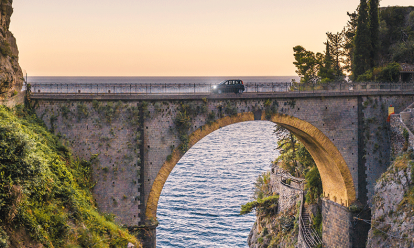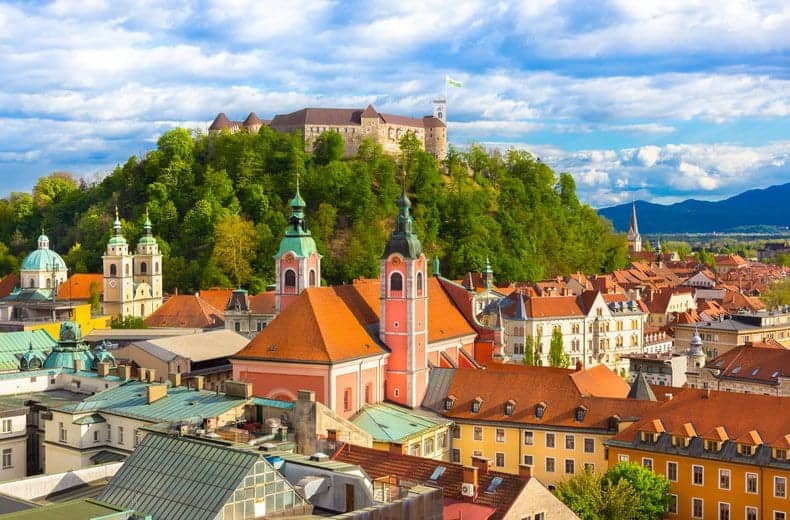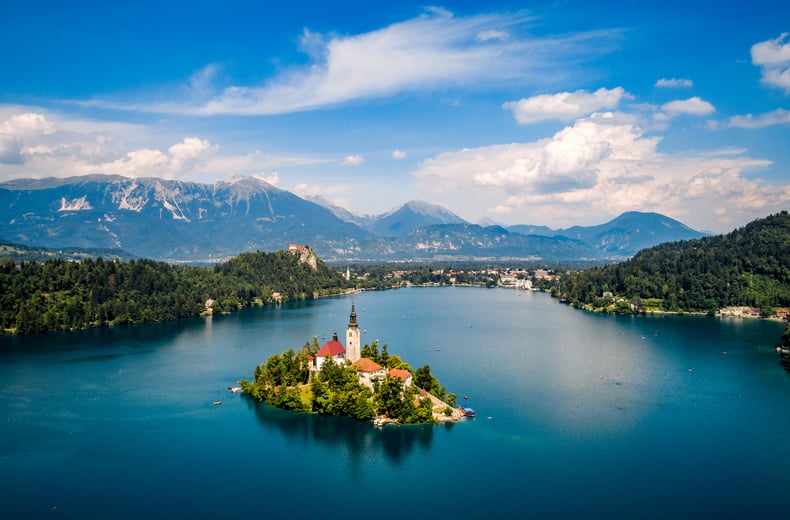Driving advice for every country in Europe
From required documents to European breakdown cover and vehicle accessories, find all the up-to-date driving laws and advice for every country in Europe in our travel guides.
Driving in Slovenia

Travelling by car is the easiest way to explore the country’s dramatic landscapes and many interesting towns, but if you’re heading to Slovenia, it’s essential you’re prepared ahead of time as driving there has many differences to the UK.
To make your trip to Slovenia as safe and effortless as possible, we’ve put together a guide to everything you need to know before you go, from required documents to rules of the road.
Driving a rented vehicle? Jump to the advice for driving a hire car in Slovenia section.
RAC European Breakdown Cover (Basic, Comprehensive and Single Trip) provides a wide range of benefits should you breakdown in Slovenia to ensure you stay safe.
To supplement this, RAC also offers travel insurance. Cover will include medical expenses, baggage, personal money and belongings, among many other benefits.

European Breakdown Cover
Get covered when driving in Europe for just £4.17 a day*.
*Price is based on European comprehensive breakdown cover for a 14 day trip, in a vehicle up to 1 year old, travelling in zone 1.

Things to take when driving in Slovenia

Documents for driving in Slovenia
- A valid, full UK driving licence (you must also be 18 or over)
- Your motor insurance certificate
- The V5 registration document for your own car or the hire car paperwork for a rental
Do I need a GB or UK sticker for driving in Slovenia?
Since 28th September 2021, the distinguishing mark (or national identifier) displayed on vehicles registered in the United Kingdom that are driven abroad has changed from GB to UK.
This means that vehicles registered in the UK must display the letters “UK” when driven in Slovenia.
The identifier can be incorporated in vehicle number plates (along with the Union Flag) or as a separate sticker. Note that vehicles featuring the letters GB together with the Council of Europe golden stars are no longer valid for driving abroad.
If your vehicle does not have the UK identifier within the number plate, you will require a UK sticker when driving in Slovenia. GB stickers will no longer be valid from the end of September.
Do I need an insurance green card?
From 2nd August 2021, drivers will no longer require an insurance green card for taking their vehicles to Slovenia.
ETIAS – 2025
ETIAS stands for the European Travel Information and Authorisation System. It is a visa program for visitors who don’t need a Schengen visa, who want to travel to the European Union and a few other European countries.
Visitors who purchase an ETIAS will be able to enter the 26 member states of the Schengen Zone as well as Bulgaria, Croatia, Cyprus, and Romania.
This will be launching in 2025. Learn more about ETIAS here.
Driving in Slovenia packing checklist
Aside from the documents above, there are some legally-required items you must bring with you to drive in Slovenia.
Unless your headlights can be adjusted, it's a legal requirement to carry headlamp converters (stickers for your headlights when driving on the right, so your lights don't dazzle motorists coming the other way).
A warning triangle is also compulsory to carry in vehicles in case of a breakdown.
It's also recommended to have:
- Spare bulbs for your car's external lights
- A fire extinguisher
- A first-aid kit
- A reflective jacket
You can pick up all the car kit you need from RAC Shop.
Is there anything that I shouldn’t take with me?
Be aware that you cannot take the following with you into Slovenia:
- meat or products containing meat
- milk or dairy products
You cannot take the following unless you pay to have them inspected before you leave and get a ‘phytosanitary certificate’:
- fresh fruit (apart from bananas, coconuts, dates, pineapples and durians)
- vegetables
- plants
- plant products
Rules of the road in Slovenia
- In Slovenia, you drive on the right and overtake on the left. Vehicles from the right and emergency vehicles have priority
- You must not indicate when entering a roundabout but should do so when leaving one
- Horns should not be used in built-up areas, except to warn of imminent danger or if the vehicle is transporting someone in need of urgent medical attention
- If you’re involved in any sort of collision, you must notify the police and get an accident report for insurance purposes
- To use Slovenian motorways, you'll need to display a vignette on your windscreen as proof of payment
- If you're caught committing a motoring offence while driving through Slovenia, the police can issue an on-the-spot fine of up to €1,200
- Seat belts must be worn at all times in both the front and rear of vehicles equipped with belts
- Children less than 150cm in height must use child restraints or seat belts adapted to their size. If the child is transported on the front seat in a rear-facing child restraint, the airbag must be deactivated
- The legal drink-drive limit in Slovenia is 0.05%. For novice drivers or those under the age of 21, there’s a zero-tolerance policy. Police can carry out roadside tests randomly or if they suspect you of being over the limit
Slovenian speed limits
The speed limit is 50km/h in built-up areas, 90-110km/h on open roads and 130km/h on motorways. There is also an increasing number of areas where the speed is limited to 30 km/h – these are indicated by the sign ‘Zone 30’
Radar detection equipment isn’t banned, but if it interferes with police radar signals, you could be fined €400
Other things you should know when driving in Slovenia

- Unleaded petrol, diesel and LPG are readily available throughout Slovenia. Most petrol stations will accept payment by credit card, and those on motorways and near large towns are usually open 24 hours a day
- There are service areas at petrol stations along the motorways
- Parking meters are used in some towns to limit parking time. Vehicles may be clamped or towed away if they’re parked illegally
In an emergency
112 - Here's a really important bit of knowledge; you can dial 112 from anywhere in Europe and an operator will connect you to an emergency service in the country you're visiting.
Operators can answer your call in their native language, English or French.
Breaking down in Slovenia
RAC offers great-value, flexible RAC European breakdown cover tailored to meet your needs. We also offer comprehensive travel insurance, including cover for medical expenses, baggage, personal money and belongings.
Driving a hire car in Slovenia
Not all of the information in the guide above will be relevant to those looking to rent a hire car in Slovenia.
Though it might be a good idea to read through everything anyway, here are the most important things to know for drivers of rental vehicles:
Rental information
- The minimum age to hire a car is 21
- You need a full, valid UK driving licence and usually a second proof of ID (passport)
- Car rental companies ask that you have held your licence for a minimum term of 2 years
- Some companies require you to use a credit card for deposit
- You may not be able to drive outside of Slovenia unless planned in advance - check with your hire company first
- Make sure you get car hire excess insurance before your trip to protect yourself from unexpected costs. It's almost always cheaper to do this with a separate insurer and in advance
Hire car driving tips
- Slovenians drive on the right and overtake on the left - the opposite to the UK
- The national speed limit on Slovenian motorways is 130km/h (80 mph). On a main road outside a built-up area it's 110 km/h. For built-up areas it’s 50km/h, unless otherwise signposted
- Dial 112 in an emergency
- It’s compulsory to wear seat belts in the front and rear seats
- The blood alcohol content limit for drivers of private vehicles is 0.05%. That's lower than the 0.08% in England Wales and Northern Ireland, but the same as Scotland.


Driving in Slovenia FAQs
- Is it safe to drive in Slovenia?
Yes, driving in Slovenia is generally very safe and trouble-free. The roads are in excellent condition and well-signposted, while traffic outside cities is light.
Slovenia is a mountainous country, which means the roads are often narrow and winding, so be careful if you’re driving in the countryside. And in summer there are frequent thunderstorms. Stop if the rain is so heavy you can’t see.
As with driving in any foreign country, it’s important to familiarise yourself with the law to ensure you stay safe on the roads.
- Can you drive in Slovenia with a UK licence?
Yes. You can legally drive in Slovenia with a full and valid UK driving licence. You do not need an International Driving Permit, although it could provide extra peace of mind if you have one.
- Do I need a green card to drive in Slovenia?
Like the UK, Slovenia is a member of the Green Card System, a Europe-wide scheme that allows countries to recognise foreign vehicle insurance policies of visiting motorists.
UK motorists are no longer required to carry a green card to drive in Slovenia, but you should check that your policy will cover you in all countries you plan to visit before setting off.
- What side of the road do they drive on in Slovenia?
As in the majority of continental Europe, motorists drive on the right-hand side of the road in Slovenia.
- Do I need a GB/UK sticker for Slovenia?
You will need to display a UK sticker on the rear of your car. GB stickers have been discontinued.
- Can I drive my car in Slovenia?
Yes, provided you’ve got all the essential documents to stay legal on the roads, including having at least third-party insurance cover.
You should also ensure you have all the required items needed for your journey in Slovenia (such as a warning triangle and headlamp converters) as well as for any other country you’re planning to drive through.
- How do I drive to Slovenia?
Getting to Slovenia from the UK is relatively straightforward, but you may want to break up your journey. Firstly, you’ll need to take your car across the Channel to Calais on either the Eurotunnel from Folkestone or a ferry from Dover.
Once you’re in Calais, drive down through France, Germany and Austria before crossing the border into Slovenia. The drive from Calais to Ljubljana takes around 13 hours non-stop.
- What age can you start driving in Slovenia?
To legally drive in Slovenia, you must be 18 years or older and in possession of a full valid driving licence.
- Are there toll roads in Slovenia?
Yes, you will need to display a toll sticker known as a vignette in your car to drive on the motorways in Slovenia.
Vignettes are available for weekly, monthly or yearly periods, and can be purchased at petrol stations, post offices and some shops near the Slovenian border. They can be paid for in cash or by credit card. Police monitor the motorways and stop motorists who don’t have a vignette. If you’re caught without one, you’ll receive an on-the-spot fine of up to €800.
- Do I need winter tyres to drive in Slovenia?
Winter tyres are mandatory between 15 November and 15 March and whenever there are wintry conditions such as snow and black ice. The minimum tread depth required is 3mm.
Snow chains are also permitted, but you’re not allowed to use spiked tyres.

European Breakdown Cover
Get covered when driving in Europe for just £4.17 a day*.
*Price is based on European comprehensive breakdown cover for a 14 day trip, in a vehicle up to 1 year old, travelling in zone 1.

UK Government travel advice
Fuel
Fuel prices in Slovenia can be found in our up-to-date European fuel prices page.
British Embassy
Trg republike 3
1000 Ljubljana
Slovenia
Email: [email protected]
Telephone: +386 1 200 39 10
Fax: +386 1 425 01 74
Consular office: [email protected]
